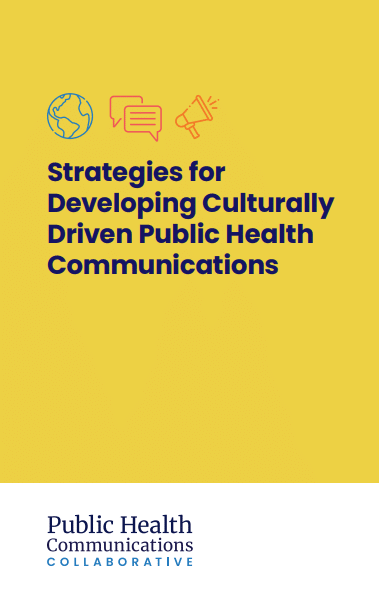Recognizing and incorporating the diversity of people’s cultures, values, and beliefs is essential to effectively communicating with multicultural audiences. Through culturally driven communications, public health professionals can prioritize the preferences and perspectives of target audiences and ensure each priority population feels represented within messaging, visuals, and outreach.
The Public Health Communications Collaborative and HCN co-created “Strategies for Developing Culturally Driven Public Health Communications” to support public health communicators in effectively communicating with multicultural audiences. This guide is divided into three sections – messaging, visuals, and outreach – to support the development of your public health communications. Each section offers strategies and tools to help you create materials that build stronger relationships, increase credibility, and improve health outcomes.
Download the Resource: Strategies for Developing Culturally Driven Public Health Communications
Share on Social
Use the links below to follow the Public Health Communications Collaborative and HCN on social media. You can also promote the “Strategies for Developing Culturally Driven Public Health Communications” resource using the following captions and graphics.
Follow us on Social
- PHCC LinkedIn: @Public Health Communications Collaborative
- PHCC Twitter: @PH_Comms
- HCN LinkedIn: @HCN
- HCN Facebook: @HCN
Sample Posts
- A new resource from [@Public Health Communications Collaborative/@PH_Comms] + @HCN promotes strategies for developing culturally driven #PublicHealth comms. Explore this latest tool to build stronger relationships, increase your credibility, and improve health outcomes in your community. [Link to resource]
- What are “culturally driven communications?” Learn more about the importance of incorporating your community’s cultures, values, and beliefs into your comms in the latest resource from @PH_Comms + @HCN. [Link to resource]
- NEW #PublicHealth Resource: Culturally driven communication emphasizes positive and authentic representation of multicultural audiences to ensure each priority population feels represented within and can relate to your messaging. Incorporate the diversity of people’s cultures, values, and beliefs in your #PublicHealth communications using the latest resource from @Public Health Communications Collaborative and @HCN. [Link to resource]
- Culturally driven #PublicHealth comms consider tone, formality + historical challenges, an are ideally created alongside their target audience. Learn more about developing culturally driven messages, visuals + outreach in a resource from [@Public Health Communications Collaborative/@PH_Comms] + HCN: [Link to resource]
- Visuals are just as essential as the messages they represent. Learn more about crafting culturally driven visuals, messaging, and outreach in “Strategies for Developing Culturally Driven #PublicHealth Communications,” developed by [@Public Health Communications Collaborative/@PH_Comms] + @HCN: [Link to resource]
- How might your #PublicHealth comms outreach be more culturally driven? Consider these tips and more in a resource from [@Public Health Communications Collaborative/@PH_Comms] + @HCN, which also includes guidance on developing culturally driven messages + visuals: [Link to resource]
More Insights from the Field
Moderated by HCN CEO, Alison Rodden, the Public Health Communications Collaborative hosted a panel discussion among three culturally driven communicators who discussed:
- The foundational principles of culturally driven communications
- The differences between cultural competency, cultural humility, and cultural sensitivity
- Actionable strategies and techniques to effectively communicate across cultures, build trust, and help advance health outcomes for all.
Access the recording of the panel discussion to learn more from Maria Griffin, Owner of Spo-ka’nay Enterprises; Erica Chung, MPH, International Health Planner at the Minnesota Department of Health; and Syreeta Wilkins, Communications Strategist at the National Resource Center for Refugees, Immigrants, and Migrants.







